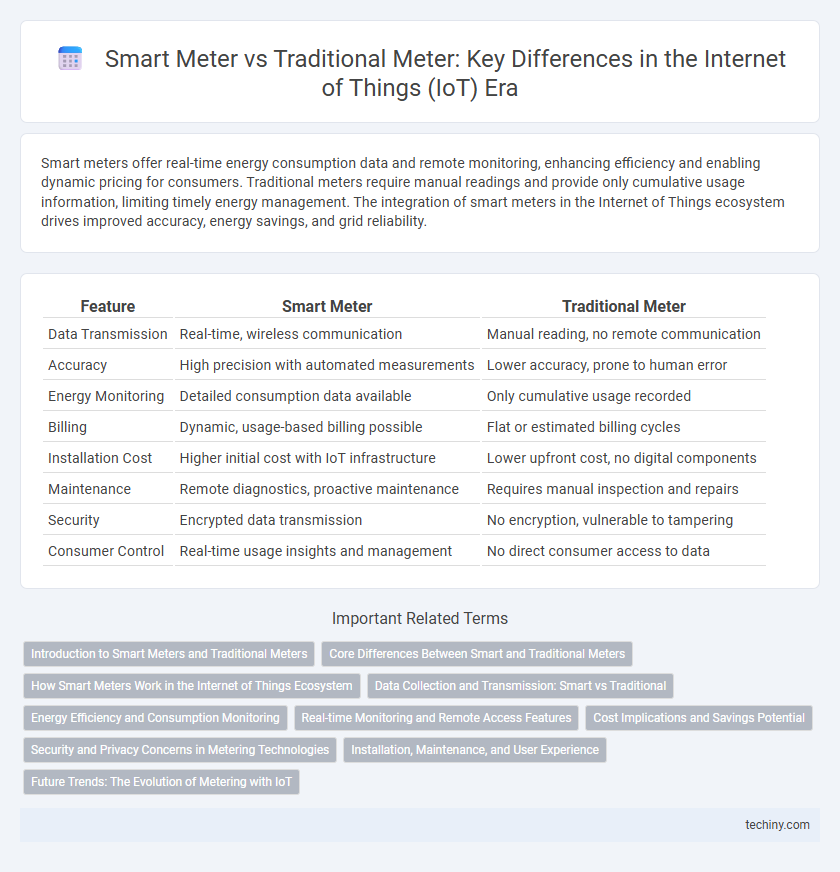Smart meters offer real-time energy consumption data and remote monitoring, enhancing efficiency and enabling dynamic pricing for consumers. Traditional meters require manual readings and provide only cumulative usage information, limiting timely energy management. The integration of smart meters in the Internet of Things ecosystem drives improved accuracy, energy savings, and grid reliability.
Table of Comparison
| Feature | Smart Meter | Traditional Meter |
|---|---|---|
| Data Transmission | Real-time, wireless communication | Manual reading, no remote communication |
| Accuracy | High precision with automated measurements | Lower accuracy, prone to human error |
| Energy Monitoring | Detailed consumption data available | Only cumulative usage recorded |
| Billing | Dynamic, usage-based billing possible | Flat or estimated billing cycles |
| Installation Cost | Higher initial cost with IoT infrastructure | Lower upfront cost, no digital components |
| Maintenance | Remote diagnostics, proactive maintenance | Requires manual inspection and repairs |
| Security | Encrypted data transmission | No encryption, vulnerable to tampering |
| Consumer Control | Real-time usage insights and management | No direct consumer access to data |
Introduction to Smart Meters and Traditional Meters
Smart meters digitally record electricity consumption and enable real-time data transmission to utilities, enhancing energy management and billing accuracy. Traditional meters rely on manual readings and mechanical dials, limiting data access and timely usage analysis. Smart meters support two-way communication and integration with smart grids, optimizing energy distribution and consumer monitoring.
Core Differences Between Smart and Traditional Meters
Smart meters provide real-time data transmission and remote monitoring capabilities, enabling accurate consumption tracking and automatic billing. Traditional meters require manual reading, which often leads to delayed data collection and potential human errors. The integration of smart meters with IoT networks enhances energy management efficiency, unlike the isolated functionality of traditional meters.
How Smart Meters Work in the Internet of Things Ecosystem
Smart meters utilize advanced sensors and communication technologies to continuously monitor and transmit real-time energy consumption data within the Internet of Things ecosystem. These devices integrate with IoT platforms via wireless networks, enabling remote management, instant analytics, and automated billing processes. Unlike traditional meters, smart meters facilitate energy efficiency and proactive maintenance by providing granular data accessible to utilities and consumers through connected applications.
Data Collection and Transmission: Smart vs Traditional
Smart meters offer real-time data collection and wireless transmission, enabling precise monitoring and instant updates on energy consumption, while traditional meters rely on manual readings taken infrequently, causing delays in data availability. Smart meters utilize advanced communication protocols such as Zigbee, RF mesh, and cellular networks to ensure continuous data flow, whereas traditional meters lack integrated communication capabilities and depend on physical visits for data retrieval. This technological advancement significantly improves accuracy, enhances utility management, and supports dynamic pricing models in smart grids.
Energy Efficiency and Consumption Monitoring
Smart meters enable real-time energy consumption monitoring, allowing consumers to optimize usage and reduce waste, unlike traditional meters that provide only periodic readings. These devices enhance energy efficiency by supporting dynamic pricing models and demand-response programs, which encourage lower consumption during peak hours. Integration with IoT platforms facilitates detailed analytics and remote management, further improving energy conservation and operational accuracy.
Real-time Monitoring and Remote Access Features
Smart meters enable real-time monitoring by continuously collecting and transmitting energy consumption data, which contrasts with traditional meters that require manual reading and periodic updates. Remote access features of smart meters allow utility providers and consumers to track usage instantly, optimize energy management, and detect outages faster. Traditional meters lack this remote accessibility, resulting in delayed data availability and less efficient energy management.
Cost Implications and Savings Potential
Smart meters offer significant cost savings by enabling real-time energy consumption monitoring, reducing energy waste, and lowering utility bills compared to traditional meters that rely on manual readings and provide no usage insights. Initial installation costs for smart meters can be higher, but the long-term savings from improved energy efficiency and demand response capabilities offset this investment. Utility companies also benefit from reduced operational expenses due to automated data collection and minimized meter reading labor costs.
Security and Privacy Concerns in Metering Technologies
Smart meters in IoT environments offer enhanced data encryption and real-time monitoring capabilities, significantly reducing risks of data breaches compared to traditional meters. Traditional meters lack robust security protocols, making them vulnerable to tampering and unauthorized access, which can compromise both consumer privacy and billing accuracy. The integration of advanced cybersecurity measures in smart meter technology ensures improved user privacy protection and mitigates potential cyber threats inherent in metering technologies.
Installation, Maintenance, and User Experience
Smart meters offer remote installation capabilities and automated calibration, significantly reducing on-site labor compared to traditional meters that require manual setup and periodic manual readings. Maintenance of smart meters is streamlined through real-time diagnostics and remote firmware updates, minimizing downtime and service visits, while traditional meters necessitate physical inspections and manual troubleshooting. Users benefit from smart meters with detailed energy usage insights and real-time alerts accessible via mobile apps, contrasting with traditional meters that provide only basic consumption data and require manual reading for billing.
Future Trends: The Evolution of Metering with IoT
Smart meters are rapidly transforming energy management by leveraging IoT technology to provide real-time data, enhancing accuracy and operational efficiency compared to traditional meters. Future trends indicate increased integration of AI and machine learning to enable predictive maintenance and dynamic energy pricing, optimizing grid performance. IoT-enabled smart meters also facilitate seamless integration with renewable energy sources and electric vehicles, driving the evolution toward smarter, more sustainable urban infrastructures.
Smart meter vs Traditional meter Infographic

 techiny.com
techiny.com